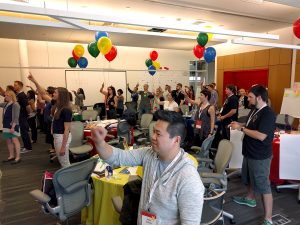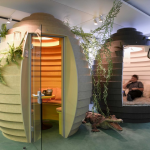Wellbeing Programmes of the Future
Thinking of creating an Engaging Wellbeing Programme? Here are some ideas that will boost your creativity!

Office pets
The popularity of Bring Your Dog to Work Day on 24 June each year means a wider range of businesses across the country are waking up to the benefits of allowing dogs at work.
Some companies are already embracing the idea that having an animal in the workplace can be beneficial to employees' wellbeing and motivation.
"Pets at work can help employees to relax, reduce heart rate and lower blood pressure, which can decrease absenteeism and improve staff morale," confirms Terri Bodell, a consultant clinical psychotherapist and stress expert.
It’s been 16 months since Nestlé began allowing its 1,000-plus employees to bring their dogs into its City Place headquarters daily. At Nestlé, staff also say the dogs help them relax. “Sometimes something will stress me out at work and I’ll go: ‘Right, I need some puppy love. And off I go to find a dog’,” says Zoe Green, a former veterinary nurse who works in the Purina team. “A few minutes later, I’m a different person.”

Using Technology and Biohacking
If you want to engage your digital generation into the wellness initiatives you should pay attention to the latest trend called Biohacking.
Biohacking is a systems-thinking approach to our own biology using the latest discoveries in health science and technology called Biotech.
Biotech is probably the most powerful and the fastest-growing technology sector. At the Biohackers gatherings you will get to experience the hyperbaric chambers, the neurofeedback booths, the ARX Fit workout machines, the nutrient injection stations, the vibration plates, the oxygen bar and the Bulletproof Coffee bar.
Too much to handle? You can start like most companies by using Fitbit or similar Fitness wristbands to track steps, calories burned, active minutes, distance, hours of sleep etc.
By 2018, more than 13 million wearable activity-tracking devices will be integrated into employee wellness programs to encourage increased physical activity and weight loss.

Delivering Healthy Snacks
Delivering Healthy Snack Boxes to the workplaces and replacing them with usual Vending Machines full of crisps and chocolates is another trend in the corporate wellness.
For example, Google employs a handful of psychological tricks in to subtlety encourage Googlers to go for fruits and veggies instead of sodas and desserts.
The company moved its popular sweets and chocolates from large, clear dispensers (similar to the ones that hold cereal on many college campuses) into opaque plastic jars. In the seven weeks after the sweets were no longer visible, employees consumed 3.1 million fewer calories.
Google also encourages employees to choose water and other healthy drinks by putting them at eye-level behind clear glass in company refrigerators. By comparison, sugary drinks like soda are housed at the bottom of the refrigerator behind tinted glass.

Paying Employees to Exercise at Work
Whether is an office yoga, a work bootcamp, a running club or a fully equipped gym, a recent study showed that employees can use work time for exercise or other health promoting measures and maintain the same level of productivity, or higher at work. Employees return from workouts refreshed and better focused on their jobs. Time lost on exercise is made back and more in terms of improved productivity.
Incorporating just 2.5 hours of exercise per week into the workday led to a noticeable reduction in absences. Workers who spent 30–60 minutes at lunch exercising reported an average performance boost of 15 percent.
Some companies are recognizing that preventative health incentives can potentially save lives—and their bottom line.
Looking for something a little different? Try GoodGym.
GoodGym a community of runners that combine getting fit with doing good. They stop off on their runs to do physical tasks for community organisations and to support isolated older people with social visits and one-off tasks they can't do on their own. It's a great way to get fit, meet new people and do some good.

Mindfulness for Stress Relief and Fun
Wait, what? Mindfulness can be FUN?
Fun is very important in our everyday lives, especially at stressful times at work. When we are happy and engaged in the present moment, we are more likely to produce our best work, to develop creative ideas and to feel confident in ourselves. Our brains release endorphins and hormones, stimulating more positive thoughts that would carry with us throughout the day.
Workplace Mindfulness can be fun as well as an important stress-relief tool. Some people relish the opportunity to close their eyes and spend a few minutes in silence, others fall asleep. But others giggle and fidget, or can’t train their thoughts to steer clear of the things that are stressing them out. There are ways to try a new approach to mindfulness at work that would engage more active people and produce similar benefits.
 Previous Post
Previous Post Next Post
Next Post



Leave a Reply